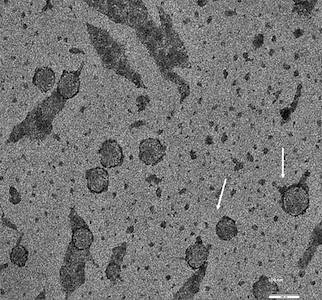Biomedical engineer Mike Davis reports he has obtained NHLBI funding to look into therapeutic applications of exosomes in cardiology. But wait. What are exosomes? Time for an explainer!
Exosomes are tiny membrane-wrapped bags, which form inside cells and are then spat out. They’re about 100 or 150 nanometers in diameter. That’s smaller than the smallest bacteria, and about as large as a single influenza or HIV virion. They’re not visible under a light microscope, but are detectable with an electron microscope.
Scientific interest in exosomes shot up after it was discovered that they can contain RNA, specifically microRNAs, which inhibit the activity of other genes. This could be another way in which cells talk to each other long-distance, besides secreting proteins or hormones. Exosomes are thus something like viruses, without the infectivity.
Since researchers are finding that microRNAs have potential as therapeutic agents, why not harness the vehicles that cells use to send microRNAs to each other? Similarly, if so much evidence points toward the main effect of cell therapy coming from what the cells make rather than the cells themselves, why not simply harvest what the cells make?
With this rationale, Davis and his recently graduated doctoral student Warren Gray have been investigating how cardiac progenitor cells release survival-promoting micro RNAs, clothed in exosomes, when they are deprived of oxygen. These survival-promoting bubbles could then be used to treat vulnerable or damaged hearts.
As a profile of Gray put it: “It’s possible that someday, a pharmaceutical company could ‘farm’ and concentrate those secreted exosomes, which might then be injected directly into damaged heart tissue.â€
“We’d hope that exosomes may be less immunogenic and allow for allogeneic therapy: from one source to another,†Davis says.
 Exosomes are isolated by intense centrifugation of the liquids left over from cultured cells. In the laboratory, cells are often cultured with the help of animal-derived products such as fetal calf serum, which contain various growth factors. Davis notes that for therapeutic purposes, progenitor cells would have to be cultured without animal products. One option could be the fibrinogen-depleted human platelet lysate material developed by Jacques Galipeau and Ian Copland.
Exosomes are isolated by intense centrifugation of the liquids left over from cultured cells. In the laboratory, cells are often cultured with the help of animal-derived products such as fetal calf serum, which contain various growth factors. Davis notes that for therapeutic purposes, progenitor cells would have to be cultured without animal products. One option could be the fibrinogen-depleted human platelet lysate material developed by Jacques Galipeau and Ian Copland.
Davis’ collaborator Charles Searles has been examining the micro RNAs found in the blood of heart disease patients – not all of which is in exosomes. Also at Emory, Russ Price and his team have been investigating exosomes containing microRNAs that could inhibit muscle atrophy.
It should be noted that the NIH illustration is probably unrealistic in depicting one molecule of RNA per exosome. Please see this transmission electron microscopy image (obtained from PeerJÂ under Creative Commons) of exosomes from breast cancer cell lines. White arrows indicate exosomes, scale bar = 100 nm.

